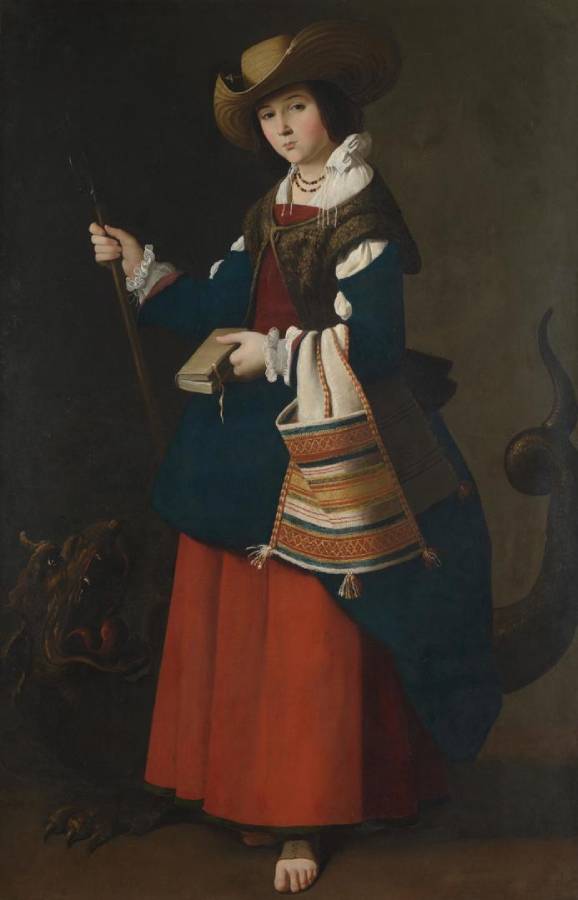Zurbarán, Francisco de (1598-1664)
Santa Margarita de Antioquía (Saint Margaret of Antioch)
1630–1634
Oil on canvas, 163 × 105 cm
National Gallery, London
The fourth-century saint Margaret was said to come from the city of Antioch. Her father, a pagan priest, cast her out when she converted to Christianity and she was left to fend for herself tending sheep. Zurbarán shows her holding a crook, with a brightly coloured saddlebag (‘alforjas’) slung over her arm. She marks a page of her prayer book with one finger, suggesting she was in prayer.
She is dressed as a wealthy shepherdess. Her white cotton shirt with curled collar and cuffs peeks through the sleeves of her blue woollen jacket (known as a ‘sayuelo’). She wears a lambskin jacket (‘pellica’) over her picturesque costume, and a wide-brimmed straw hat is fashionably cocked on her head. Her simple sandals are made of leather – you can see the stitching on them really clearly.
Margaret seems oblivious to the snarling dragon crouched at her feet; she gazes directly towards us with a sober, determined expression. The creature is condemned to darkness behind the glowing saint. According to the Golden Legend, a medieval compilation of saints’ biographies, the dragon – Satan in disguise – devoured her. She burst from its belly unharmed and later assumed the role of patron saint of childbirth, the dragon becoming her symbol.
The strong lighting emphasises the saint’s flawless skin and the vibrant colours and rich textures of her clothing, but also the scales on the dragon’s curled tail, its piercing eyes and pointed fangs. Her head and dress show the artist’s careful and smooth painting technique: the brushstrokes are particularly difficult to see in her skin tones. His attention to detail is obvious in the pattern and texture of her woven saddlebag, which is decorated with colourful stripes and geometric patterns.
Unlike most of Zurbarán’s paintings of female saints, which were commissioned as series and largely painted by assistants, this one is entirely by the artist himself and does not appear to be part of a series. Zurbarán worked for churches and monasteries in and around Seville, where he lived from 1629, and in Extremadura. Many of his works were exported to South America: in 1647 he received an order for 24 paintings of virgin saints for Lima, Peru, and two years later he sent 15 paintings of the same subject to Buenos Aires, Argentina. During the 1640s he produced several series of virgin saints, but this one probably dates from the previous decade.
Zurbarán’s intensely spiritual paintings perfectly express the ideas of the Counter-Reformation – compare this work with his other saints in our collection: Saint Francis in Mediation and Saint Francis in meditation. (NG)
